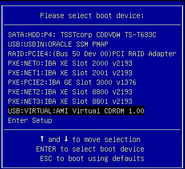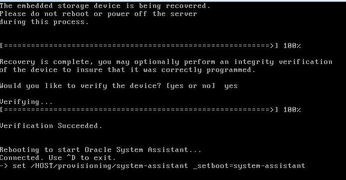| Skip Navigation Links | |
| Exit Print View | |

|
Sun Server X3-2 HTML Documentation Collection |
Getting the Latest Software and Firmware
Preparing the Site for Installation
About the Installation Procedure
Installation Procedure Overview
About Server Features and Components
Front Panel Status Indicators, Connectors, and Drives
Back Panel Status Indicators, Connectors, and PCIe Slots
Server Management Software Overview
Preparing for Server Installation
Tools and Equipment Needed for Installation
Optional Component Installation
Installing the Server Into a Rack
Safety Precautions When Rackmounting the Server
Stabilize the Rack for Installation
Attach Tool-less Slide-Rail Assemblies
Install the Server Into the Slide-Rail Assemblies
Install the Second-Generation Cable Management Arm
Remove the Second-Generation Cable Management Arm
Install the First-Generation Cable Management Arm
Rear Cable Connections and Ports
Attaching Data Cables and Power Cords to the Server
Oracle ILOM Hardware and Interfaces
Logging In to Oracle ILOM Using a Local Serial Connection
Logging In to Oracle ILOM Using a Remote Ethernet Connection
Accessing the Host Console Through Oracle ILOM
Troubleshooting the Service Processor Connection
Setting Up Software and Firmware Using Oracle System Assistant
Setting Up an Operating System and Drivers
Configuring Server Drives for OS Installation
RAID Configuration Requirements
Configuring Storage Drives Into RAID Volumes Using Oracle System Assistant
Configuring RAID Using the BIOS RAID Configuration Utilities
Configuring the Preinstalled Oracle Solaris 11 Operating System
Preinstalled Operating System RAID Limitations
Oracle Solaris Configuration Worksheet
Configure the Preinstalled Oracle Solaris 11 Operating System
Oracle Solaris 11 Operating System Documentation
Configuring the Preinstalled Oracle Linux 6.x Operating System
Oracle Linux 6.x Configuration Worksheet
Configure the Preinstalled Oracle Linux 6 Operating System
Register and Update Your Linux Operating System
Oracle Linux Operating System Documentation
Configuring the Preinstalled Oracle VM 3.x Software
Preinstalled Oracle VM Server and Oracle VM Manager Compatibility Requirements
Oracle VM Server Configuration Worksheet
Configure the Preinstalled Oracle VM
Controlling System Power and Troubleshooting Installation Issues
Power Off the Server for Orderly Shutdown
Power Off the Server for Immediate Shutdown
Technical Support Information Worksheet
Locating the System Serial Number
Getting Server Firmware and Software
Firmware and Software Access Options
Getting Firmware and Software from MOS or PMR
Installing Updates Using Other Methods
About Oracle Solaris Operating System Installs
Oracle Solaris OS Installation Task Map
Selecting the Console Display Option
Selecting the Boot Media Option
Selecting the Installation Target Option
Oracle Solaris OS Installation Options
Preparing to Install the Operating System
Installing the Oracle Solaris Operating System
Installing Oracle Solaris 10 or 11 Operating System on a Single System Using Media
Getting Server Firmware and Software
Firmware and Software Access Options
Getting Firmware and Software From MOS or PMR
Installing Updates Using Other Methods
Oracle VM Installation Task Map
Selecting the Console Display Option
Selecting the Boot Media Option
Selecting the Installation Target Option
Oracle VM Installation Options
Single-Server Installation Methods
Assisted Oracle VM Installation
Oracle System Assistant Overview
Oracle System Assistant Install OS Task
Obtaining Oracle System Assistant
Preparing to Install Oracle VM
Verify the BIOS Factory Defaults
Installing Oracle VM on a Single System Using Oracle System Assistant
Installing Oracle VM on a Single System Using Media
Post Installation Tasks for Oracle VM
Configuring Network Interfaces
Getting Server Firmware and Software
Firmware and Software Access Options
Getting Firmware and Software From MOS or PMR
Installing Updates Using Other Methods
About Linux Operating System Installs
Supported Linux Operating Systems
Oracle Unbreakable Enterprise Kernel for Linux
Selecting the Console Display Option
Selecting the Boot Media Option
Selecting the Installation Target Option
Oracle System Assistant Overview
Preparing to Install the Operating System
Configuring the SLES 11 SP1 Operating System Software to Support Network Connections
Installing the Linux Operating System
Installing a Linux OS on a Single System Using Oracle System Assistant
Installing Oracle Linux on a Single System Using Media
Installing Red Hat Enterprise Linux on a Single System Using Media
Installing SUSE Linux Enterprise Server on a Single System Using Media
Configuring Network Interfaces
Getting Server Firmware and Software
Firmware and Software Access Options
Getting Firmware and Software From MOS or PMR
Installing Updates Using Other Methods
About Microsoft Windows Server Operating System Installs
Windows OS Installation Task Map
Supported Windows Operating Systems
SAS PCIe HBAs Requiring LSI Mass Storage Driver for Windows Server 2008 SP2
Selecting the Console Display Option
Selecting the Boot Media Option
Selecting the Installation Target Option
Windows OS Installation Options
Oracle System Assistant Overview
Preparing to Install the Operating System
Installing Windows Server Operating System
Installing Windows Server on a Single System Using Oracle System Assistant
Installing Windows Server on a Single System Using Media
Post Installation Tasks for Windows Server
Supplemental Software Component Options
Installing Device Drivers and Supplemental Software
Getting Server Firmware and Software
Firmware and Software Access Options
Getting Firmware and Software from MOS or PMR
Installing Updates Using Other Methods
VMware ESXi Installation Task Map
Supported VMware ESXi Software
Selecting the Console Display Option
Selecting the Boot Media Option
Selecting the Installation Target Option
VMware ESXi Installation Options
Preparing to Install VMware ESXi
Configuring the VMware ESXi 5.0 Software or the Server Hardware to Support Network Connections
Installing VMware ESXi on a Single System Using Media
Post Installation Tasks for VMware ESXi
Configure Network Adapter Settings
Determine the MAC Address of a Connected Server Network Port
Update the VMware ESXi Software
Configuring Network Interfaces
Getting Server Firmware and Software
Firmware and Software Access Options
Getting Firmware and Software from MOS or PMR
Installing Updates Using Other Methods
About Server and Component Status Indicators
Service Troubleshooting Task List
Locate the Server Serial Number
Electrostatic Discharge Safety
Preparing the Server for Component Replacement
Servicing CRUs That Do Not Require Server Power Off
Servicing Storage Drives (CRU)
Servicing Power Supplies (CRU)
Servicing CRUs That Require Server Power Off
Servicing the Internal USB Flash Drives (CRU)
Servicing the Disk Backplane (FRU)
Servicing the Front Indicator Module (FRU)
Servicing the Motherboard (FRU)
Servicing the SAS Cables (FRUs)
Returning the Server to Operation
Removing and Installing Server Filler Panels
Reinstall the Server Chassis Into the Rack
Return the Server to the Normal Rack Position
Reconnect Data Cables and Power Cords
Getting Server Firmware and Software
Firmware and Software Access Options
Getting Firmware and Software From MOS or PMR
Installing Updates Using Other Methods
Planning the System Management Environment
Choosing Tools for Single System Management
Choosing Tools for Multiple System Management
System Management Tools Overview
Common System Management Tasks
Common System Administrative Tasks
Evaluating the Server Environment
Installing System Management Tools
System Management Documentation
Accessing System Management Tools
Accessing Oracle System Assistant
Accessing Oracle Hardware Management Pack
Setting Up Software and Firmware
Set Up Software and Firmware Using Oracle System Assistant
Set Up Software and Firmware Using Oracle ILOM
Set Up Software and Firmware Using Oracle Hardware Management Pack
Setting Up the Server Using Oracle System Assistant
Organization of Oracle System Assistant
Configure the Server Using Oracle System Assistant
View Oracle System Assistant ReadMe File
Exit From Oracle System Assistant
View System Inventory Information
Get Platform Software Release Updates
Configure MOS to Enable Oracle System Assistant Updates
Configure Hardware for the Oracle ILOM SP
Set Preferences to Disable Oracle System Assistant
Set Preferences for Keyboard Language
Perform Advanced Tasks to Access Oracle System Assistant Shell
Perform Advanced Tasks to Check Media Integrity
View Files on the Oracle System Assistant USB Flash Drive
View Documentation From Oracle System Assistant
Mounting the Oracle System Assistant USB Flash Drive
Mount the Oracle System Assistant USB Flash Drive on Oracle VM 3.0
Mount the Oracle System Assistant USB Flash Drive on a Linux Operating System
Mount the Oracle System Assistant USB Flash Drive on an Oracle Solaris 10 Operating System
Troubleshooting Oracle System Assistant
Verify Oracle System Assistant Is Installed
Troubleshoot Oracle System Assistant Launch From Oracle ILOM
Accessing the Oracle System Assistant Filesystem
Access the Oracle System Asistant Filesystem
Managing the Server Using Oracle ILOM
Oracle ILOM Features for Oracle x86 Servers
Supported HBA Disk Controllers
Creating a RAID Volume Before Installing an Operating System
Creating a RAID Volume After Installing an Operating System
Using Oracle ILOM to Monitor Storage Devices
Setting Up BIOS Configuration Parameters
Managing the BIOS Configuration
Accessing the BIOS Setup Utility
Using BIOS for Resource Allocation
Common BIOS Setup Utility Tasks
BIOS Setup Utility Menu Options
UEFI Driver Control Menu Selections
BIOS Save & Exit Menu Selections
Monitoring Components and Identifying SNMP Messages
Monitoring Component Health and Faults Using Oracle ILOM
Identifying SNMP Trap Messages
Getting Server Firmware and Software
Firmware and Software Access Options
Getting Firmware and Software from MOS or PMR
If Oracle System Assistant has been erased, overwritten, or corrupted, you can download the image file that is available from the My Oracle Support web site to restore an update image of Oracle System Assistant to the USB device.
The package name for the update image for the server is:
Sun Server X3-2 (X4170 M3) SWversion – Oracle System Assistant
Download the image that is specific to your server. For example, you could download the image:
Sun_Server_X3-2 (Sun_Fire_X4170_M3)-x.x.x.yyyyy-ORACLE_SYSTEM_ASSISTANT_UPDATER.iso
Where x.x.x is the release number and yyyyy is the build number of Oracle System Assistant.
For information about accessing My Oracle Support and downloading this image, see Download Firmware and Software Using My Oracle Support.
Use the image file to burn a physical DVD image. Install the DVD in the server's DVD drive or in a DVD drive attached to the server. You can also make the DVD available to the server as a redirected DVD by using the Oracle ILOM Remote System Console application.
Make the update image file available to the server as an ISO image using the Oracle ILOM Remote System Console application.
For example:
From the local server, press the Power button (approximately 1 second) on the server front panel to power off the server, then press the Power button again to power on the server.
From the Oracle ILOM web interface, click Host Management > Power Control and select Reset from the Select Action list box.
From the Oracle ILOM CLI on the server SP, type reset /System
The BIOS screen appears.

Note - The next events occur very quickly; therefore, focused attention is needed for the following steps. Please watch carefully for these messages as they appear only briefly on the screen.
The Please Select Boot Device screen appears.
Note - The items listed in the Please Select Boot Device menu might differ, depending on whether the system was booted in Legacy BIOS or UEFI Boot Mode. The following screens reflect a Legacy BIOS boot.
If you chose to burn a DVD and placed the DVD into the server's DVD drive or into an attached DVD drive, select SATA:HDD:P4:TSSTcorp CDDVDW TS-T633C as shown in the following Please Select Boot Device menu, then press Enter.

If you chose to use the Oracle ILOM Remote System Console application to make the image available to the server as a redirected DVD or as an ISO image, select USB:VIRTUAL:AMI Virtual CDROM 1.00 as shown in the following Please Select Boot Device menu, then press Enter.

A message appears and a prompt asks whether you want to continue the restore process.

The following message appears, indicating the progress of the restore process, and, when the process completes, asks whether the restored Oracle System Assistant USB flash drive should be verified to ensure that it was programmed correctly.

It is recommended that you perform this integrity check of the USB device.
The following screen appears, indicating that the Oracle System Assistant USB device was verified successfully. The system then reboots and launches the Oracle System Assistant application.

The following screen appears, indicating that the restore process is complete. The system then reboots and launches the Oracle System Assistant application.
